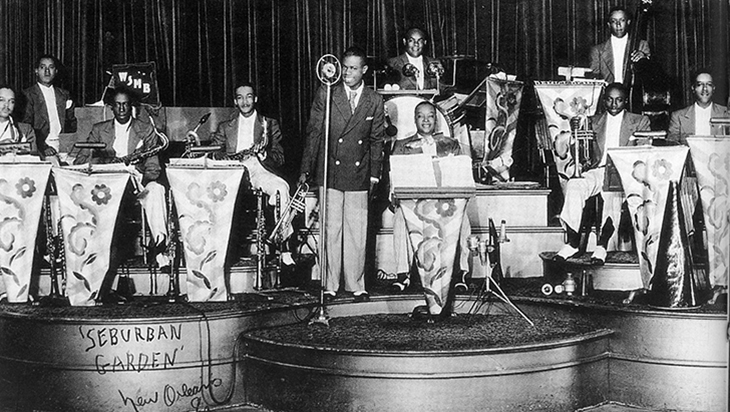Pops, on a "flight" from Chicago

Louis Armstrong (center) used a gig at the notorious "Seburban" (Suburban) Gardens club as a cover while hiding out from mobsters, says Bruce Raeburn, curator of the Hogan Jazz Archive. (Photo courtesy Hogan Jazz Archive)
When in 1931 Louis Armstrong landed a three-month gig at Suburban Gardens in Jefferson Parish, then “one of the most significant nightclubs in the South,” it wasn"t just a celebratory homecoming for the musician. He was hiding out from the mob, says jazz historian Bruce Boyd Raeburn.
Raeburn, curator of the Hogan Jazz Archive and Tulane University adjunct professor of history, will talk about the circumstances that led to the historic gig during Satchmo SummerFest on Saturday (Aug. 1) at the Old U.S. Mint.
Raeburn says Armstrong was in Chicago when, following a dispute between managers over his contract, “armed thugs” confronted the musician and told him to honor commitments in New York rather than stay in Chicago.
To steer clear of the mob in either city, Armstrong traveled to New Orleans, which “was just far enough away to provide a safe haven for him,” Raeburn says.
That he ended up at Suburban Gardens was remarkable, the historian adds: The club was owned by Mark Boasberg, also known as Jack Sheehan a Prohibition-era bookmaker, smuggler, bootlegger and philanthropist. It was open only to white audiences. And by the time Armstrong arrived, Sheehan himself was close to a federal conviction and the loss of his club. Nonetheless, “he created the conditions under which Armstrong could be hired, because Sheehan had consistently used black jazz bands, despite the objections of the white musicians" union,” Raeburn says.
The next year, a written review of acts at Suburban Gardens listed Armstrong along with the nation"s top white bandleaders. “In 1931, for an African-American jazz-orchestra leader to be mentioned with the upper crust of pop-music impresarios and entertainers ⦠was a major accomplishment. And this was in many ways the beginning of his crossover into becoming not just popular in the black community but celebrated by the entire American population.”
Raeburn will discuss “Suburban Gardens: The Checkered Past of Louis Armstrong"s 1931 "Home Away from Home"” on Saturday (Aug. 1) at 1:30 p.m. inside the Old U.S. Mint, 400 Esplanade Ave.
New Orleans “was just far enough away to provide a safe haven for him.”—Bruce Raeburn, curator, Hogan Jazz Archive
